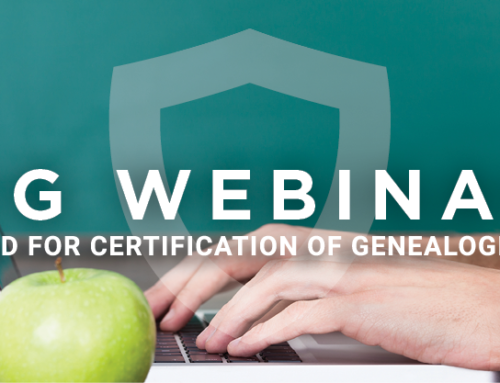President’s Corner by Elissa Scalise Powell, CG®, CGL℠
as printed in the September 2014 issue of OnBoard (v. 20, no. 3): 19.
New Tools, New Techniques, Same Standards
This summer has seen much attention to the art and science of using genetic evidence in genealogy. Workshops, institute courses, and genetic genealogy conferences have shared what the field can do for genealogical problem-solving. OnBoard has published recent articles to this effect, and Elizabeth Shown Mills’s article “Testing the FAN Principle Against DNA: Zilphy (Watts) Price Cooksey Cooksey of Georgia and Mississippi” appeared in the NGSQ.(1) It is a new and exciting field of evidence, which each user must understand before effectively using the techniques to break through their own brick walls.
When solving a problem, we consider: Is the evidence consistent with what else we know? Can it be “lying” to us, as in a false positive? Is there enough evidence to make our case? Can we resolve conflicts in the evidence? The elements of the GPS are important for building a reliable proof and DNA evidence is just one part of that proof. It behooves each of us to understand this new marriage of genetics and genealogy, even if we never practice it ourselves.
BCG Wants Applicants to Succeed
There is always a general curiosity about what percentage of certification applicants are successful. The number varies from year to year because the applicants’ portfolios vary from year to year. Certification is not a “numbers game,” but rather it’s about whether or not you understand the Genealogical Proof Standard and can demonstrate that understanding by adhering to the standards. There is no other “secret sauce” ingredient, although following the directions given in the free downloadable BCG Application Guide is key. It is amazing how many applicants don’t follow the advice to “1. Read the directions. 2. Do the work. 3. Read the directions again to make sure the work follows the directions.” This applies to every applicant, even those who think they know what to do based on experience in other fields. Genealogy has its own terminology and standards— make sure you understand and use them.
In a field where “you don’t know what you don’t know,” it is helpful to have a system by which you ask three evaluators to give you independent feedback on how your work measures up against standards. The benchmark is Genealogy Standards.(2) If you read its short seventy-nine pages and find yourself nodding, “yes, I do that, and this other just makes common sense,” then you are more likely to succeed because you have internalized the standards. Making the standards a part of our every-day work habits pervades everything we do, including the work we send to BCG for evaluation. If that is the case then we demonstrate our abilities and meet standards.
If you would like a general overview of what it takes to become certified, or perhaps you know someone who is curious, a good resource is the free webinar that I did for Legacy Family Tree in July. You can see the details and link to the free recording in the BCG SpringBoard blog: http:// bcgcertification.org/blog/2014/07/free-bcg-certification-webinar. In addition, BCG just announced that it is offering its own free webinar series. Details can be found on SpringBoard.
BCG wants applicants to succeed! Whether for a new application or a renewal, we try to make every aspect of the evaluation process as transparent as possible. The rubrics (used by evaluators to rate submissions) are available at http:// www.bcgcertification.org/brochures/ BCGNewAppRubrics2014.pdf. To better prepare your application, use the rubrics and their corresponding standards to evaluate your work samples. It is another “lens” through which to check your submission—and the same one evaluators will be looking through.
To help the public understanding of standards and rubrics, I will be giving a workshop at the Association of Professional Genealogists (APG) Professional Management Conference (PMC) on Thursday, 8 January 2015, in Salt Lake City, Utah. “Measuring Yourself Against Standards: A Practical Guide for Improving Your Skills” will have participants working with documents, research reports, and standards, and doing self-evaluation with rubrics. See https:// www.apgen.org/conferences/index.html for more information.
The certification process is like a mirror that reflects an honest picture of where you currently stand on the genealogy education continuum. What you see in that reflection, and what you do about it, are up to you. We hope that if you don’t like the picture at first, you take the evaluators’ comments to heart and seek the needed skills. Then ask again for another evaluation on new material. You may be successful on a subsequent attempt, as one recently certified person did with her third portfolio application. You can bet she is proud of her achievement, but it took perseverance, determination, and skill-building to work through premature applications to come to the point where she could be successful. What else can BCG do to help you become the skilled genealogist you want to be?
1. Elizabeth Shown Mills, “Testing the FAN Principle Against DNA: Zilphy (Watts) Price Cooksey Cooksey of Georgia and Mississippi,” National Genealogical Society Quarterly 102 (June 2014):129–52.
2. Genealogy Standards (Nashville, Tenn.: Ancestry.com, 2014).


